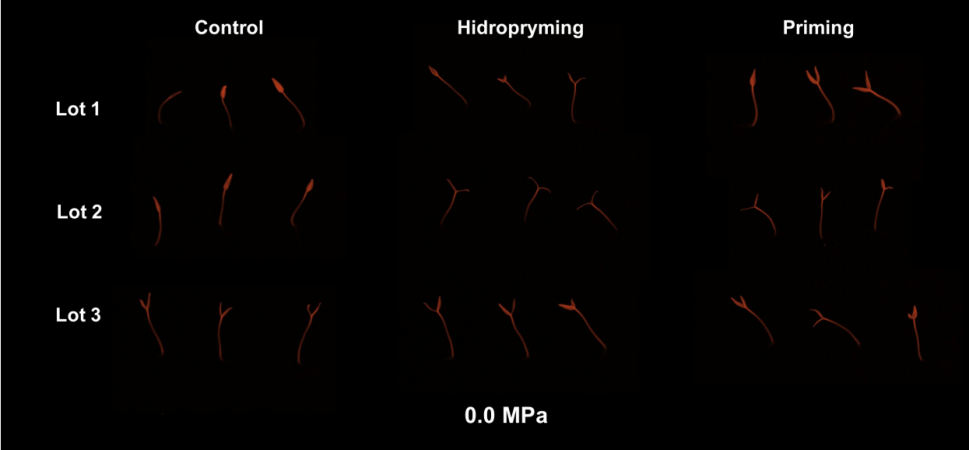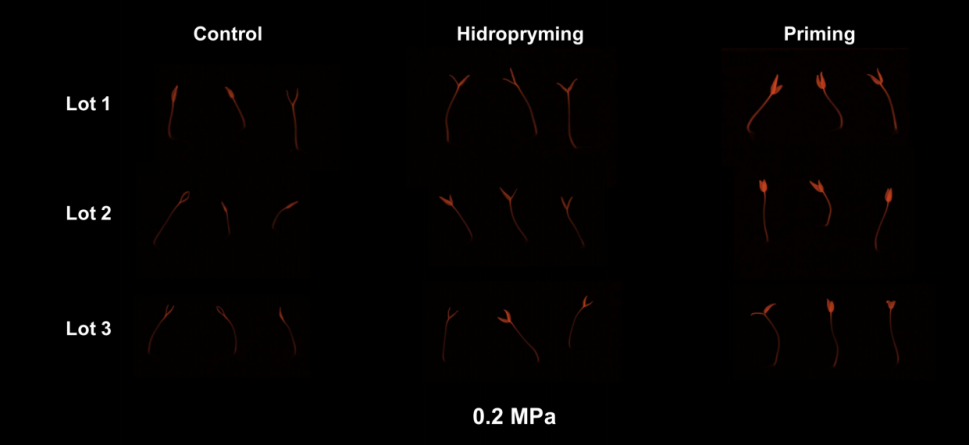品质至上,客户至上,您的满意就是我们的目标
应用案例
当前位置: 首页 > 应用案例
WIWAM表型成像系统叶绿素荧光成像模块:辣椒种子叶绿素荧光研究
发表时间:2024-09-11 10:56:06点击:449
来源:北京博普特科技有限公司
分享:
WIWAM叶绿素荧光成像模块是革新性的植物叶绿素荧光成像系统,是专门针对整个植株成像的相机系统,成像方式为远程成像,高分辨率和高速成像。生成图像提供了光合作用性能信息。该模块有两种版本: 高分辨率版本和高速版本。同时配有分析软件,可为科学研究和工业应用提供少有的解决方案。所依据的原理是基于持续激发成像荧光计,用以测量Kautsky响应曲线。采用了高能红灯来使光合作用饱和,通过使用敏感相机,在不同时间点对相应曲线成像以测量F0和Fm。依赖于所拍摄图像的有效信号/噪音比,相机积分时间是从20µs-1ms。红光灯的典型照射强度是1000-5000µmol/(m2s)。
高通量版叶绿素荧光成像系统的应用
高通量版叶绿素荧光成像系统可用于高度可控环境中进行高清多光谱成像。6Mp-16 bit相机安装在直角坐标型机器人系统上,用于监控大量幼苗以小植株(15cm)生物胁迫效应(例如,真菌病害 ) 和生物胁迫(如干旱)。基于高度自动化sensor-to-plant原理,疾病扩散或胁迫因子效应可在植物生长时进行追踪。另外,系统可进行小植株如浮萍Lemna minor或生长在多孔板中的部分进行成像。
系统还整合了RGB成像、叶绿素荧光、花青素、NIR以及GFP/RFP成像,系统可以多种方式对生物、非生物胁迫进行成像。另外,可咨询在LAMP组织(或紧密协作单位)内的有图像处理经验的研究者,通过这些图像科学计算相关测量参数,从而获取现象可视化植物的解读。系统安装在高度可控的环境中,可控环境参数包括温度、相对湿度以及照明光光谱特征(可达1000 8molm-2 s-1)。系统专门定制了自动浇水系统,用于植物浇水,同时可执行多个浇水方案。
辣椒种子启动和盐胁迫诱导后幼苗叶绿素荧光的研究
摘要
叶绿素荧光分析是一种在研究人员中广泛传播的方法,用于确保快速、准确和无损的结果。因此,本研究旨在评估在三种浓度(0.0、-0.2和-0.4 MPa)的盐胁迫诱导后,由未经预处理、加水引发预处理和10-8 M的24-EpiBL预处理的种子生长的辣椒幼苗的叶绿素a荧光。为进行实验,使用了种子光谱相机和彩色成像系统。使用了三批辣椒品种“Biquinho”的种子。在种子经受不同程度的盐胁迫后的第七天,对幼苗中的叶绿素荧光进行了评估。通过CFTI-Analysis软件(4.5版)分析获得的叶绿素荧光图像。一般来说,通过获得的数据,可验证用24-EpiBL预处理的种子生长的幼苗中叶绿素a荧光增加。简而言之,叶绿素荧光技术被证明是可行和有效的,而且是一种实用的工具,可用于支持辣椒幼苗质量的分析,无论是否受到盐胁迫条件的影响。


关键词:图像分析、比奎诺品种;seedreporter.
Chlorophyll fluorescence in pepper seedlings after seed priming and induction of salt stress
ABSTRACT
Chlorophyll fluorescence analysis is a method that has been widely disseminated among researchers for ensuring fast, accurate and non-destructive results. Thus, this study aimed to assess the chlorophyll a fluorescence of pepper seedlings grown from seeds that were unprimed, hydroprimed and primed with 24-EpiBL at 10-8 M after induction of salt stress at three concentrations (0.0, -0.2 and -0.4 MPa). To carry out the experiment, the Seed Reporter Camera Spectral & Color Imaging System (PhenoVation Life Sciences, Wageningen, Netherlands) was used. Three lots of seeds of the pepper cultivar ‘Biquinho’ were used. Chlorophyll fluorescence in the seedlings was evaluated on the seventh day after the seeds were subjected to different levels of salt stress. The chlorophyll fluorescence images obtained were analyzed by the CFTI - Analysis software (version 4.5). Through the data obtained it was possible to verify that, in general, there was an increase in chlorophyll a fluorescence in seedlings grown from seeds primed with 24-EpiBL. In short, the chlorophyll fluorescence technique proved to be viable and efficient, in addition to being a practical tool that can be used to support the analysis of the quality of pepper seedlings, whether or not subjected to saline stress conditions.
Keywords: image analysis; ‘biquinho’ cultivar; seedreporter.